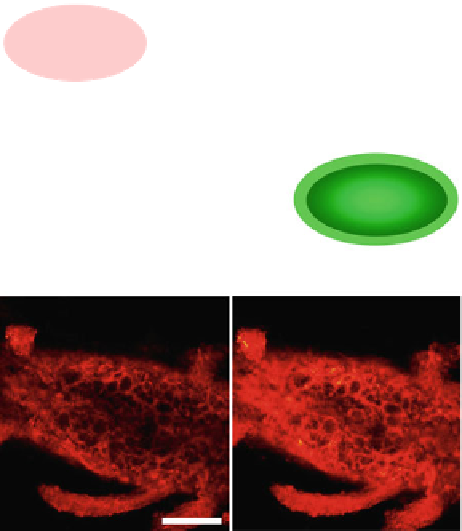Biomedical Engineering Reference
In-Depth Information
Fig. 6.3
Nitric oxide (NO)
detection using a fl uorescent
probe. (
a
) Mechanism for
detecting the release of NO
using the fl uorescent probe
DAF-2. DAF-2 DA is cell
membrane permeable because
of its acetoxymethyl residue.
After crossing the cell
membrane, DAF-2 DA is
transformed into DAF-2,
which is not membrane
permeable, by esterase
activity in the cell. Finally,
DAF-2 captures NO and
changes its form to DAF-2T
and fl uoresces. Notice that the
fl uorescent intensity of
DAF-2T does not decrease
with NO decrease. (
b
) Typical
imaging of spontaneous NO
production in the ventral
nerve cord of the earthworm
(modifi ed from Kitamura
et al.
2001a
,
b
)
a
Cell membrane
DAF-2 DA
NO
DAF-2T
DAF-2
b
Control
5 min
Ventral side (20 µm depth, bar=100 µm)
associative learning between vibration (conditioned stimulus) and light (uncondi-
tioned stimulus) in the earthworm. Furthermore, the injection of serotonin into the
body cavity enhances the acquisition of this associative learning. These results indi-
cate the essential interest in NO and associative learning, and quantitative investiga-
tions between NO production and learning are required. We, therefore, developed
an NO-selective microelectrode (Kitamura et al.
2000
,
2003
) for further study.
6.4
Activity-Dependent Observation of the Presynaptic
Region with FM1-43
The typical locomotory behavior of the earthworms is creeping. The earthworm shrinks
and elongates its body wall periodically with the regular contraction of the circular and
longitudinal muscles. We found that the neural activity of this muscle contraction is
induced by a neuromodulator, octopamine, without effectors or sensory feedback
(fi ctive locomotion). The application of octopamine to the isolated VNC induces rhyth-
mic neuronal activity observed in the segmental nerve cord, and the frequency of this
neuronal activity depends on the concentration of octopamine (Mizutani et al.
2002
,





